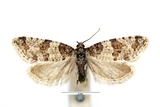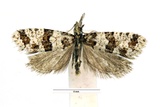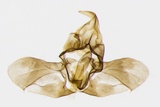Isotrias rectifasciana (Haworth, 1811) Species
Last modified: Nov. 21, 2025, 7:34 p.m.
A very rare and local species in Belgium, observed mostly in the southern part of the country.
Details
- Classification
- Family: Tortricidae > Subfamily: Chlidanotinae > Genus: Isotrias > Species: Isotrias rectifasciana
- Vernacular names
- V-bandbladroller (NL), Hedge Tortrix (EN), La Sciaphile albuline (FR), Südlicher Weißdornwickler (DE)
- Synonyms
- Isotrias albulana (Treitschke, 1835)
- First mention in Belgium
- Fologne E., Sauveur J., Colbeau J. & Peteau A. 1861. Compte rendu d'une excursion entomologique faite aux environs de Dinant et de Rochefort au mois de juillet 1860. — Annales de la Société entomologique belge 5: 12–32. On page 13 (as albulana). view page
- Status
-
Native
Distribution
Imago
Species with pronounced sexual dimorphism: male usually larger (wingspan 14–16 mm) than female (wingspan 11–14 mm). Antenna of the male rough-scaled, minutely ciliate; female with antenna simple.
Forewing ground colour cream-white, markings ochrous-brown sprinkled with black. Hindwing pale brownish grey. Variation limited.
Resembles a Cnephasia species but has a dark fascia at the base of the forewing.
Bionomics
The adults are active at dusk and later come to light.
Flight periods
The adults fly in one generation from late April untill the end of July.
Observed on
- Substrates:
- Unknown
The larval food plant is little known. In captivity, larvae fed on Crataegus and Ulmus from a silk tube on the underside of a leaf. The pupa has been beaten from Crataegus, potentially a larval food plant. Also Quercus and Acer are mentioned.
Habitat
It inhabits xerothermic habitats.







